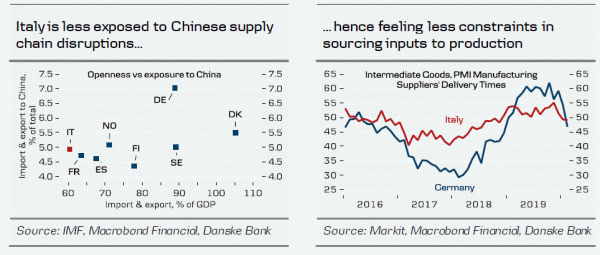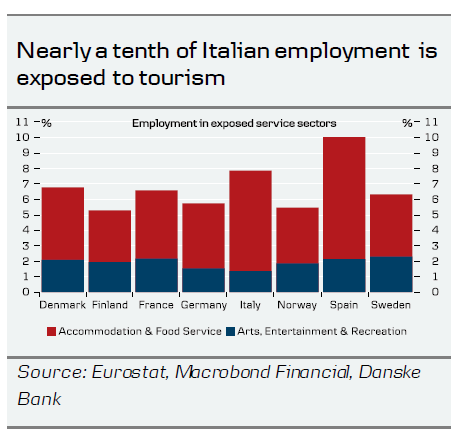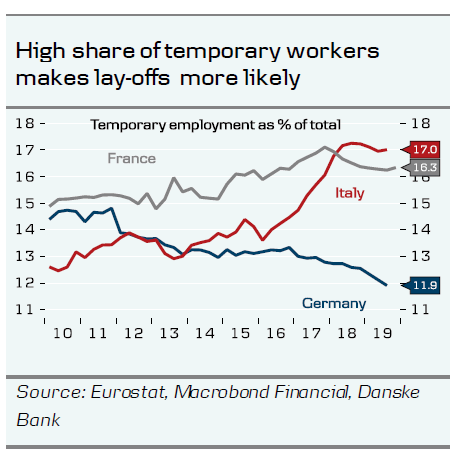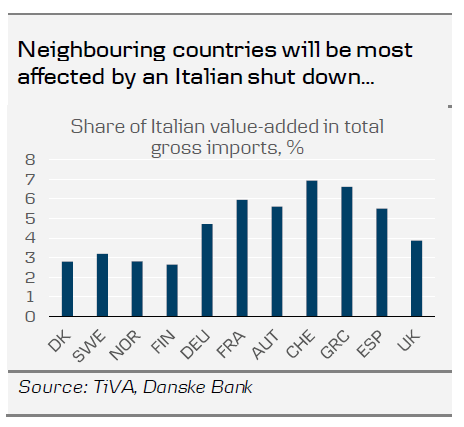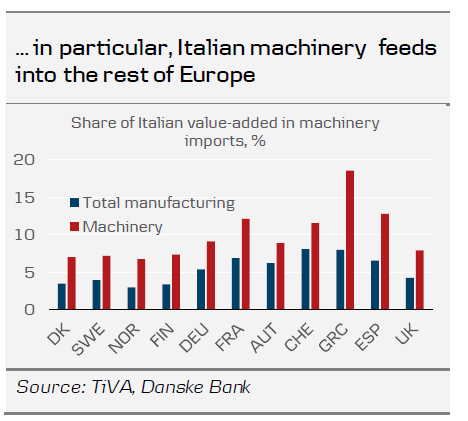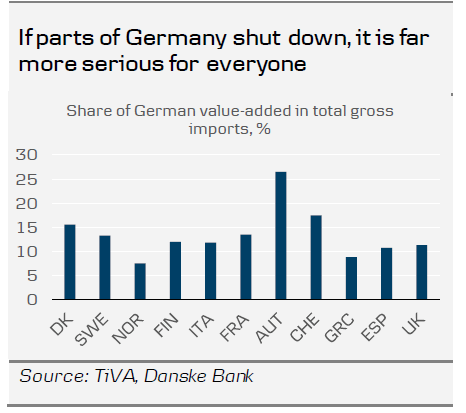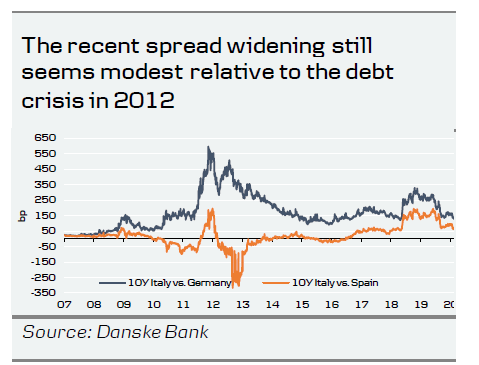- Italian growth to see a big hit in H1 that risks pushing its debt to GDP ratio above 140% by the end of the year.
- Brussels to apply leniency with budget and state aid rules. An Italian ESM programme remains an option of last resort.
- Italian shutdown will hit neighbours’ supply chains the hardest.
- Italian banks to struggle with loan loss provisioning and lower profitability, while sovereign-bank linkages remain significant.
- As long as Italy can avoid significant rating downgrades, we do not expect Italy to run into major funding problems.
Yet again Italy has found itself at the epicentre of a crisis, battling with the most severe coronavirus outbreak globally after China. With the number of COVID-19 cases standing at 9,172 (at the time of writing), Italy has now even overtaken South Korea and the number of new infections continues to climb. Since the first COVID-19 infections where registered on 22 February, measures to contain the virus have been successively stepped up, culminating in nationwide school closures and travel bans on 10 March.
With the movement of some 60 million people severely restricted for an unknown period of time and companies, both public and private, encouraged to put their staff on leave, Italy’s coronavirus crisis is rapidly turning from a humanitarian one to an economic one as well. Already at the end of 2019, the Italian economy was balancing on the brink of recession due to continued European industry headwinds and slowing consumer spending. Since 2018, services – accounting for 74% of gross value added – has been the main driver keeping the Italian economy afloat, much like in the rest of Europe. Government measures, such as the citizen income, also contributed to this. However, with the whole country essentially in lockdown, a sharp decline in service sector activity across sectors is likely on the cards. Neither does the outlook for manufacturing bring much cheer. On a positive note, Italy ‘s direct exposure to Chinese supply chain disruptions is more limited than for example Germany ‘s. However, widespread production closures will still take their toll on industry output and we would not be surprised to see a quarterly growth contraction of -0.75 to -1.0% q/q in Q1.
While Italy’s approach has been to take drastic measures in the short-term to prevent a wider economic crisis, we see a risk that the repercussions of the lockdown will be headwinds for the economy that extend into Q2 or even Q3. As an important travel destination, Italian businesses will feel the pinch from a sharp fall in tourism activity across Europe in the spring and summer. Tourism receipts account for 2.5% of GDP in Italy and around 8% of the workforce is directly employed in hospitality -linked services, but interlinkages into other related service sectors will magnify the impact. An important catalyst for the severity and length of the recession will be the labour market in our view. As companies face liquidity constraints as turnover declines, many SMEs will try to slash staffing costs. And with Italy already having one of the highest shares of temporary and precarious jobs in Europe, job and income losses again risk pro-longing the Italian recession.
The government seems to be aware of the problem and has launched a EUR7.5bn (0.4% of GDP) emergency package, including possible debt moratoriums to ease pressure on companies, and state guarantees to support banks. Moratoriums on companies’ payments of tax and welfare contributions are also being discussed. The extra spending will lead Italy to overshoot its budget deficit commitments by EUR6.3bn this year, taking the planned deficit from 2.2% to 2.5% of GDP. Given the impact from automatic stabilizers, such as higher unemployment benefits, as the economy tanks, the actual deficit might end up even higher. Although Brussels has signalled flexibility to Italy’s temporary deviation from EU fiscal rules, the risk of a more pro-longed Italian recession has seen concerns about Italian debt sustainability come back to the market. Despite another fall in borrowing costs in 2019, lacklustre growth has pushed Italy ‘s debt to GDP ratio up at 137.3% of GDP at the end of Q3 19 (from 134.8% in 2018). A back of the envelope calculation reveals that even with a relatively ‘mild’ recession of -1.0% in 2020 and no increase in borrowing costs, the debt ratio will likely overshoot the 140% threshold by the end of the year. A more severe recession scenario combined with a bigger fiscal support package, as recently hinted by Deputy Finance Minister Antonio Misiani, and a subsequent increase in debt servicing costs could even push the ratio closer to 145% of GDP in 2020.
Brussels to apply leniency – ESM programme only as last resort
We think that the EU will be ready to assist Italy to overcome the dire humanitarian and economic situation in the country. As a first line of assistance, the European Commission (EC) together with the Euro group have signalled flexibility with regard to the fiscal rules under the Stability and Growth Pact to accommodate the higher fiscal deficit. We also think that Brussels will consider using flexibility in both its state aid rules to help EU governments cushion businesses from the hit from coronavirus, as well as in banks’ rules on the treatment of non-performing loans, including when a loan is considered nonperforming. Finally the EU can seek to utilise its solidarity fund, which was set up in 2002.
If Italy eventually should lose market access, the country can access funds from the European Stability Mechanism Fund (ESM). However, assistance from ESM would typically come with stringent conditionality and create stigma in the eyes of the financial markets. The possible ESM assistance could be given either in the form of an active programme or an Enhanced Conditioned Credit Line (ECCL), which is a precautionary lending facility. Both programmes would allow the ECB to activate the OMT (outright monetary transactions) programme (which is a bond purchase programme focussing on the 1-3y segment in potentially unlimited size), which would limit the credit risk associated with the Italian government securities. However, the high local ownership of government bonds by the banks and financial institutions would likely then also force a severe banking crisis. In response to a banking crisis, either the ESM ‘s bank recap italisation programme could be activated in severe cases, or the ECB’s ELA p rogramme could provide a backstop for solvent financial institutions facing temporary liquidity problems and, as during the height of the Greek crisis, it could be used to provide Italian banks with liquidity during a potential crisis period.
All of the above carries a certain stigma to it, making the ESM option only a last resort for Italy. Looking ahead, and while we should never attach a zero probability to an EU political response, the ESM ‘s fund could be turned into a humanitarian fund controlled by the EC, however, this would be pure speculation at this point.
Italian shutdown will hit neighbours’ supply chains the hardest
Besides the direct effect on the domestic economy, the Italian shutdown will also cause ripple effects through the rest of Europe as supply chains are interrupted. Ordinary trade data shows the direct trade between two countries but will not give you the full picture of a country ‘s significance to its trading partners. Global value chains have grown increasingly complex over the years, and thus one needs to look at the value added along the value chain to understand a country ‘s significance its trading partners. That is what the OECD’s trade in value added data (TiVA) tries to take account of by measuring one country ‘s value added in another country ‘s imports.
In the EU, particularly neighbouring countries such as Switzerland but also France, will be affected by the Italian shutdown, the Nordics less so. Germany also has quite strong ties to Italy. That is, 4.7% of total German imports are produced in Italy and either directly imported or imported via other countries which use Italian intermediate goods in their production. Germany has a particularly large dependence on Italy when it comes to foods and thus German consumers stand to be hit here, along with some neighbouring countries. Food products, typically imported for consumption, are subject to substitution, and thus do not play as large a role in global value chains as for instance machinery; here Spain, France, and in particular Greece, are the most affected countries. In the Nordics, Italian imports represent a relatively large share of machinery imports, which could cause supply issues for Nordic manufacturers as well.
Of the Nordics, Sweden is the most dependent on Italian imports, which is largely due to significant imports of construction services – a sector that has boosted Swedish growth for several years but is now declining sharply in activity. Overall, production in the Nordics is likely to be significantly less interrupted by the Italian shutdown than much of the rest of Europe. At the time of writing, Germany is close to being on the same trajectory as Italy concerning the development in the number of COVID-19 infections, just about a week delayed. If the path continues and Germany will have to shut down production in parts of the country, Nordic companies will be looking at a whole other scale of supply issues. 16% of the value of Danish imports is made in Germany; that same number is 13% in Sweden and 8% in Norway.
Italian banks to struggle with loan loss provisioning and lower profitability
The Italian banking sector is likely to be impacted by the COVID-19 crisis in a number of ways.
First, through asset risk, as the deteriorating macroeconomic outlook will hit banks’ already high ratios of problem loans (standing at around 8% of gross lending versus the EU average of 3% based on Bank of Italy and EBA data). Under the new accounting rules adopted at the beginning of 2018 (IFRS 9), loan loss provisioning has become more pro-cyclical as banks must set aside provisions corresponding to the expected loss over the lifetime of the loan as soon as there is a significant deterioration in credit risk. The latter is assessed using forward-looking indicators including macroeconomic scenarios and, based on the weaker economic environment, we would thus expect Italian banks to report rising loan loss provisions in the coming quarters.
Second, banks’ profitability is likely to suffer due to lower economic activity as well as potential initiatives to suspend mortgage repayments during the virus outbreak (such measures have already been implemented by UniCredit and Intesa Sanpaolo in the affected regions, and today Italy ‘s deputy finance minister Laura Castelli has said that this could be implemented across the entire country, see Financial Times, although it remains unclear how this will be funded). Generally speaking, we expect smaller banks to be more affected by the challenging domestic operating environment than say UniCredit, which has a well diversified income stream.
Third, although Italian banks have been reducing exposure to domestic government bonds, given holdings of EUR334bn by September 2019, the sovereign-bank linkages remain significant. Nonetheless, according to Bank of Italy, 62% of holdings are held at amortised costs, thus shielding the imp act from p rice fluctuations on banks’ equity to some extent.
Fourth, current market turmoil is making funding conditions more challenging, although this is mitigated by the Italian banking sector being largely funded through deposits and having limited wholesale funding needs, Moreover, outstanding TLTRO-II tranches are likely to be rolled over into the TLTRO-III in the coming months, in our view.
Finally, it should be noted that Italian banks have gradually increased their capital levels in recent years and thus their resilience to economic shocks. Nonetheless, as underlined by the recent stress test of less significant banks undertaken by Bank of Italy, some of the smaller banks have limited ability to withstand adverse economic conditions.
Funding situation and implications for BTPs: it is not as bad as it looks
Currently Italy’s funding need for 2020 is EUR247bn, where EUR202bn stems from redemptions and EUR45bn from new borrowing. The Italian government plans to spend at least EUR7.5bn due to the outbreak of coronavirus, and more stimulus is likely if the economic situation deteriorates even more. On top of this, there is likely to be a revenue loss given the lower economic activity as discussed above.
We have already seen a significant spread widening between Italy and core -EU as well as the other peripheral markets as shown by the chart at right, but we are very far from the levels/spreads seen during the European debt crisis in 2012, though higher than during the financial crisis back in 2008. We are still not back to the levels seen in 2018, when the formation of a Lega Nord and 5SM government rattled markets.
A key risk going forward is that rating agencies signal imminent downgrades as the fiscal outlook deteriorates and the budget deficit escalates well beyond 3% of GDP. Currently, the consensus forecast for the Italian budget deficit in 2020 and 2021 is 2.5% of GDP and only one forecaster among the Bloomberg consensus forecasters has a budget deficit above 3%.
However, even if the Italian government increases public spending and there is a loss of revenue such that the budget deficit slips some 2%-3% of GDP for 2020, then this is equivalent to an increase in funding of some EUR40bn-50bn according to our calculations. If we assume this is funded partly by T-bills and partly by nominals and linkers, then the spread impact is likely to be modest as the Italian Debt Office sells in 0-coupon bonds, floaters and fixed rate bonds. Hence, if there is a spilt of 50-50 between T-bills and nominals, then T-bill issuance would increase by EUR20-25bn, while the issuance of nominal bonds and linkers would increase by EUR20-25bn for the rest of the auctions in 2020. Italy has had two auctions per month for the last nine months. Hence, there are 18 auctions at which the Italian Debt office would have to sell between EUR1- 1.5bn extra per auction. This is manageable in our view.
The expected increase in the issuance of T-bills has to some extent already been priced in, as the yield of the longest dated Italian T-bills are now trading with a positive yield again. So even if the budget deficit increased to 4-5%, then we will not necessarily see a “sup p ly shock” in the BTPs as the Italian Debt Office has a variety of funding tools.
However, if the increase in the deficit is seen to be a credit negative and the rating agencies place Italy on negative watch or even downgrade Italy, this could lead to a sell-off from foreign investors and lead to a vicious circle, where yields rise and the spread widens on Italian government bonds. Currently, foreign investors own some 32% of the Italian sovereign debt (end of November 2019) as the political uncertainty slowly receded during 2019. However, a sell-off as seen in 2011-12, when foreign investors reduced their share from 40% to 30%, would have a very negative impact on the Italian government bond market. In 2011-2012, it was mainly the Italian banks that bought the bonds together with the domestic life insurers, pension funds and asset managers. We expect that they will continue buying Italian government bonds as these can be funded at the ECB.
Short term, we could see some more spread widening, but an increase in the budget deficit of some 2-3% could be funded with a combination of both bonds and bills. In this case, the biweekly auctions are expected to be increased by EUR1-1.5bn if we assume that part of the increase in the funding need is financed by T-bills.
Italy should NOT run into funding problems even if the budget deficit is increased, as long as this does not lead to a downgrade of the Italian rating. Currently, Italy is rated Baa3/BBB/BBB/BBB(H) by Moody ‘s/S&P/Fitch/DBRS and the outlook is Stable/Negative/Negative/Stable. Thus Italy is rated 1 notch/2 notches/2 notches/3 notches above Junk by the rating agencies. We take all four rating agencies as Italy just needs one IG-rating to be part of the PSPP programme and eligible for ECB repos etc. As long as Italian bonds are eligible with the ECB, then Italian banks can in theory borrow money from the ECB and buy bonds from the Italian Debt Office. Furthermore, as long as Italy has an IG rating from either Moody ‘s, Fitch or S&P, it will be included in the major bond indices.





